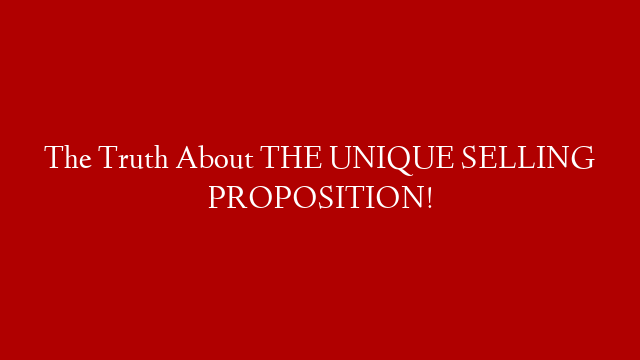“Promise, large promise, is the soul of an advertisement.” But how do you make a big promise in your advertising that is powerful enough to convince the consumer to buy your product instead of competing brands?
One way is to develop a compelling USP, or Unique Selling Proposition.
What is a USP? Is a term that describes the major advantage of your product over the competition? The idea is this: If your product is no different from or better than other products of the same type, there is no reason for consumers to choose your product over someone else’s. Therefore, to be promoted effectively, your product must have a Unique Selling Proposition: a major benefit that other products in its category don’t offer.
There are three requirements for a USP.
1. Each advertisement must make a proposition to the consumer. Each must say, “Buy this product, and you will get this specific benefit.”
Your headline must contain a benefit-a promise to the reader.
2. The proposition must be one that the competition either cannot, or does not, offer. Here’s where the unique in Unique Selling Proposition comes in. It is not enough merely to offer a benefit. You must also differentiate your product from other, similar products.
3. The proposition must be so strong that it can move the mass millions, i.e., pulls over new customers to your product. The differentiation cannot be trivial. It must be a difference that is very important to the reader.
Why do so many advertisements fail?
One reason is that the marketer has not formulated a strong USP for his product and built his advertising upon it. Formulating a USP isn’t difficult, but it does take some thinking, and many people don’t like to think. But when you start creating direct mail and advertising without first thinking about what your USP is, your marketing is weak because there is nothing in it to compel the reader to respond. It looks and sounds like everyone else, and what it says isn’t important to the reader.
In general advertising for packaged goods, marketers achieve differentiation by building a strong brand at a cost of millions or even billions of dollars.
Most businesses are too small, and have too strong a need to generate an immediate positive return on investment (ROI) from their marketing, to engage in this kind of expensive brand building. So we use other means to achieve the differentiation in our USP.
One popular method is to differentiate your product or service from the competition based on a feature that your product or service has and they don’t.
The common error here is building the USP around a feature that, while different, is unimportant to the prospect, and therefore unlikely to move her to try your product or service.
The easiest situation in which to create a strong USP is when your product has a unique feature-one that competitors lack-that delivers a strong benefit. This must be an advantage the customer really cares about. Not one that, though a difference, is trivial.
But what if such a proprietary advantage does not exist? What if your product is basically the same as the competition, with no special features? Here is the answer, the uniqueness can either stem from a strong brand, other products may also have this feature, but advertisers haven’t told consumers about it.
An example from packaged goods advertising: “M&Ms melt in your mouth, not in your hand.” Once M&M established this claim as their USP, what could the competition do? Run an ad that said, “We also melt in your mouth, not in your hand!”?
Four ways to advertise seemingly similar products
1. Stress an under-publicized or little-known benefit. Study your list of product features and benefits. Then look at the competition’s ads. Is there an important benefit that they have ignored, one you can embrace as the Unique Selling Proposition that sets your product apart from all others?
Once a copywriter visited a brewery in the hopes of learning something that could set the brewery’s beer apart from other beers. He was fascinated to discover that beer bottles, like milk containers, are washed in live steam to kill the germs. Although all brands of beer are purified this way, no other manufacturer had stressed this fact. So the copywriter wrote about a beer so pure that the bottles are washed in live steam, and the brew’s Unique Selling Proposition was born.
2. Dramatize a known benefit in a compelling fashion.
Radio Shack once ran a commercial showing two people using walkie-talkies, with each person standing on a different side of the Grand Canyon. Although most walkie-talkies work effectively over this distance, the Radio Shack commercial aimed to call attention to its product by demonstrating the walkie-talkie’s range in a unique and dramatic fashion.
3. Dramatize the product name or package.
Remember “Pez,” the candy that came in plastic dispensers made to resemble Mickey Mouse, Pluto, and other cartoon characters? Pez was an ordinary candy, but the package made it special.
4. Build long-term brand personalities.
Another tactic used by the manufacturers of major national brands is to create advertising that gives their brand a “personality.”
Thousands of Marlboro-man commercials once made Marlboro a “macho” cigarette.
The old Don Meredith spots drummed into the consumer’s mind that Lipton Tea is “brisk” and “dandy tasting.”
If you have millions to spend, you can use advertising to give your product a unique “personality” in the mind of the consumer. But even if your advertising budget is more modest, you can still use features and benefits to create a Unique Selling Proposition that sets your product apart from the rest.



